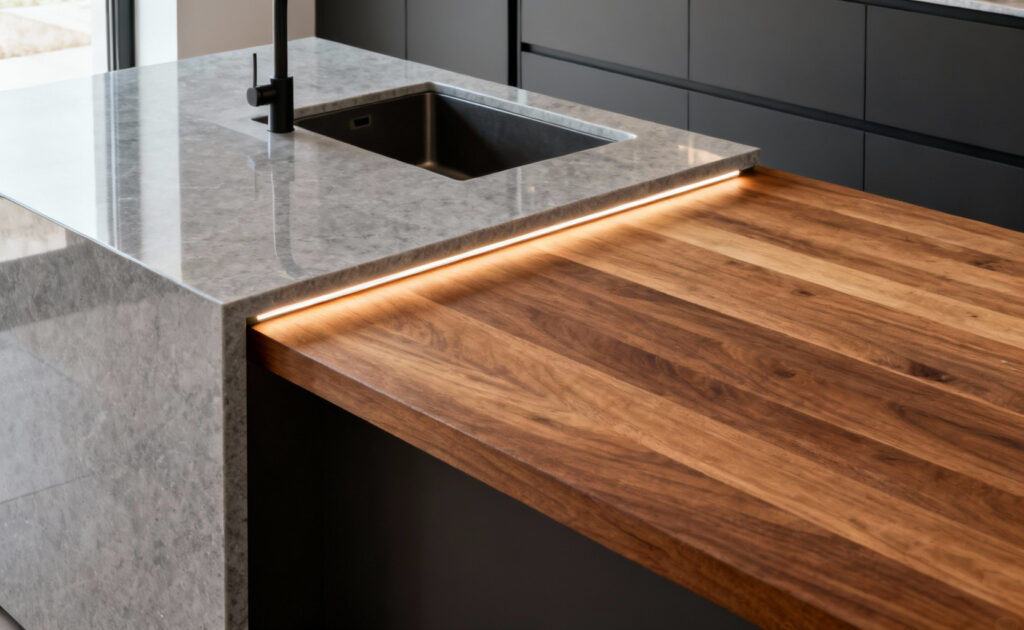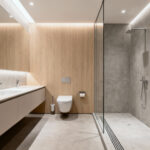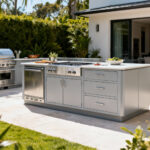The kitchen island is the modern heir to the ancient hearth—the primal center of the home where meals were prepared, stories were told, and life unfolded. It’s evolved from a simple work table to a sophisticated, multifunctional hub. Today’s most successful kitchens understand this dual role. A truly great island must be a workhorse of peak functional utility and, at the same time, a profound aesthetic statement.
In my work blending modern needs with the soul of historic homes, I’ve learned that this central element is where architecture meets daily life most intensely. The twenty principles that separate a thoughtfully sculpted island from a merely functional block aren’t fleeting trends. They are enduring tenets of good design. This isn’t just about adding countertop space; it’s about sculpting the true epicenter of your home, an investment that demands precision, thoughtful materiality, and an eye for the future. We’ll explore the core concepts that make an island work, the advanced applications that make it innovate, and the deeper philosophy that gives it a soul.
Foundational Concepts: Crafting the Ergonomic and Spatial Nexus (Part 1)
Before an island can be a beautiful centerpiece, it must first be a masterpiece of function. This is about the invisible architecture of use—the ergonomics and spatial dynamics that make it intuitive. Let’s lay the groundwork for an island that serves not just as a visual anchor, but as a meticulously engineered tool for better living.
1. Precision Zoning for Culinary Workflow Efficiency: Defining Micro-Regions
A great island isn’t one big surface; it’s a collection of smartly defined micro-regions, each designed for a specific task. Think of it like a chef’s station in a professional kitchen. The goal is to choreograph movement—prep, cooking, cleanup—so that it’s fluid and intuitive. This thoughtful mapping of function minimizes wasted steps and creates an effortless flow.
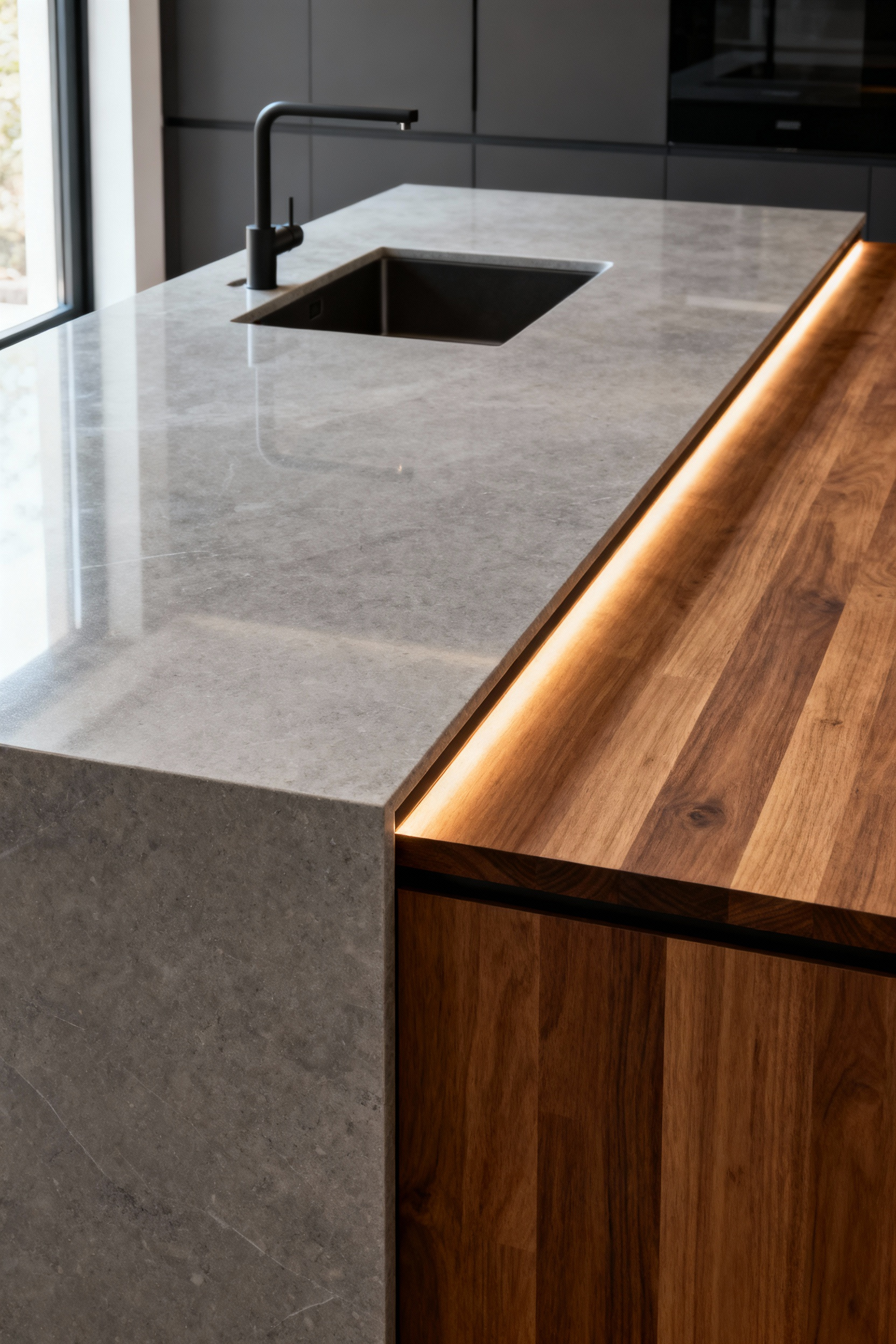
I always advise clients to map their most common kitchen tasks. We create a “wet zone” with an auxiliary sink for rinsing produce, a spacious “dry zone” for chopping and assembly, and a “hot zone” for a cooktop or as a landing area for things coming off the main range. This logical progression means you can move from refrigerator to sink to prep area to cooktop without crisscrossing the kitchen. The real magic happens when multiple people can work together without getting in each other’s way—one person rinsing vegetables while another chops, all in their own distinct, functional space.
2. Strategic Materiality Selection for Durability, Aesthetics, and Tactile Richness
Choosing materials is about more than just looks; it’s a statement about how the island will be used and how it will age. The surfaces must be incredibly durable, ready for impacts, heat, and spills, but they also need to contribute to the home’s aesthetic story. High-performance surfaces like engineered quartz or sintered stone are fantastic for their resilience, but they can feel a bit cold.
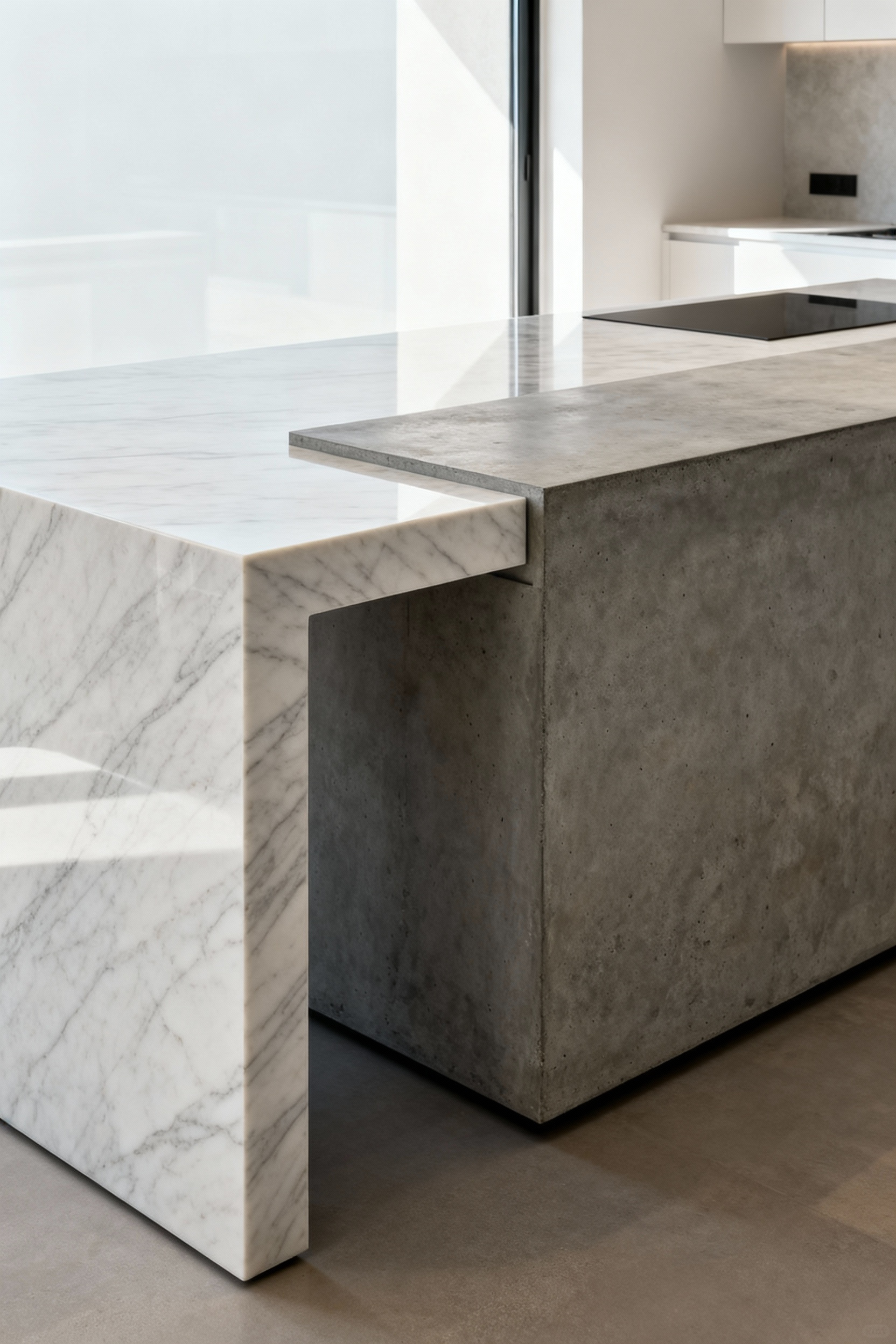
What I love to do in my historic home renovation practice is create a dialogue between materials. We might use a durable, sleek quartz for the main work area and then integrate a thick, oiled slab of walnut for the seating area. This introduces a crucial tactile richness and visual warmth, tempering the modernity. The interplay of materials—polished concrete for a base, stainless steel for a specific task area—creates a rich sensory experience. The goal is to choose a palette that will age with grace, developing a beautiful patina rather than just looking worn out.
3. Integrating Structural Anchoring for Aesthetic Cohesion and Enduring Stability
An island should feel permanent and solid, as if it grew out of the floor. That sense of stability comes from robust structural anchoring, something that’s decided long before the countertops arrive. Whether it’s directly bolted to reinforced subflooring or uses a concealed steel frame for a cantilevered effect, the structure is fundamental to its integrity and its aesthetic.
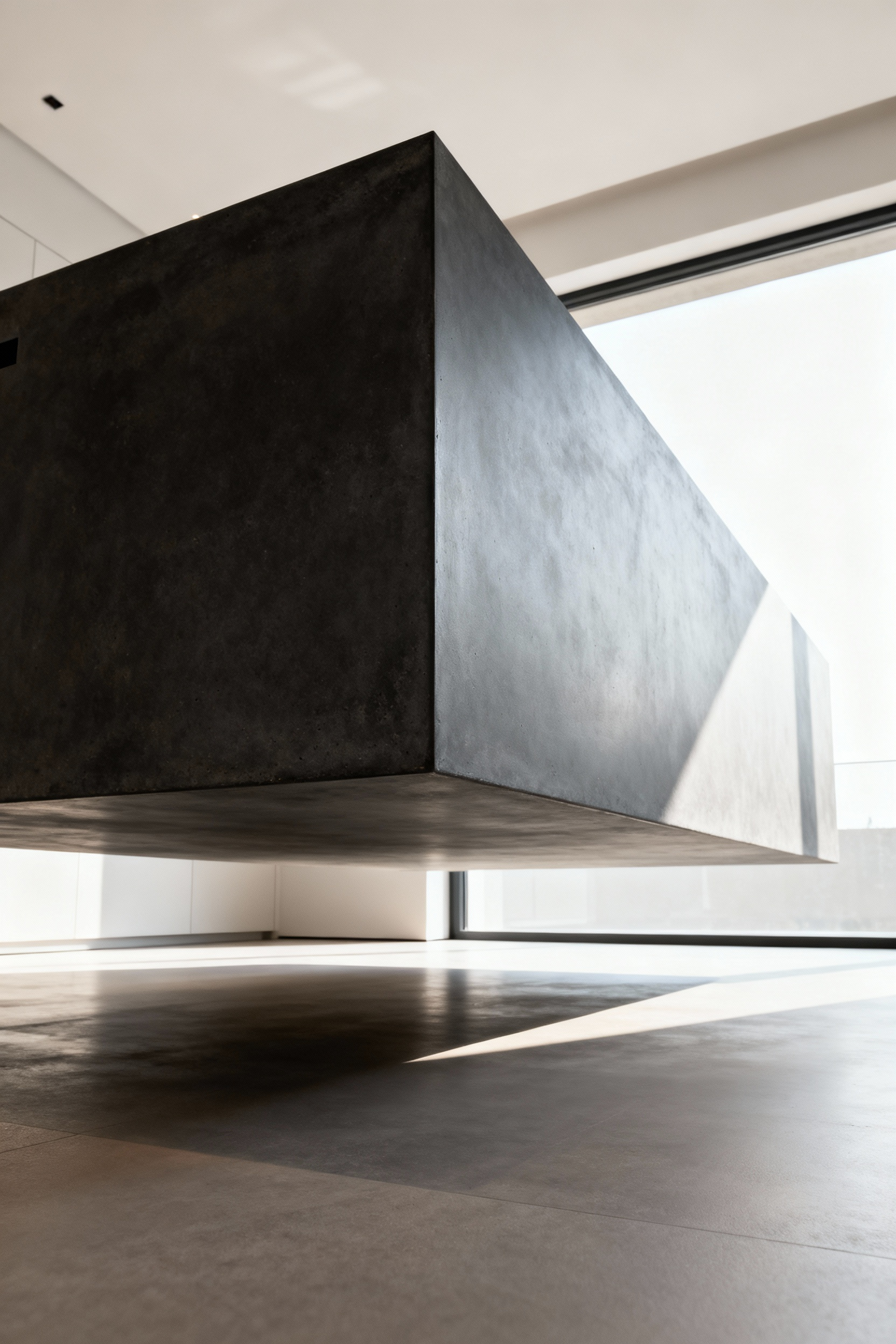
A heavy, monolithic island needs a strong core to support the immense weight of stone and appliances, preventing any chance of sagging or cracking over time. But where this gets really interesting is in designs that appear to float. That illusion is only possible because of a precisely engineered and completely hidden steel framework. When you consider the structure as part of the design from day one, it lends a visual groundedness—or a graceful lightness—to the piece. The goal is for the island to feel as solid and well-crafted as a piece of heirloom furniture, asserting its presence without any fuss.
4. Optimizing Transitional Space for Seamless Kitchen-Living Interaction
In modern open-plan homes, the island is the crucial mediator between the kitchen and the living space. Its design must manage this transition thoughtfully. This isn’t just about leaving enough room to walk by; it’s about choreographing flow, light, and social interaction. I stick to a minimum of 42 inches of clearance in a work aisle, and 48 inches is even better.
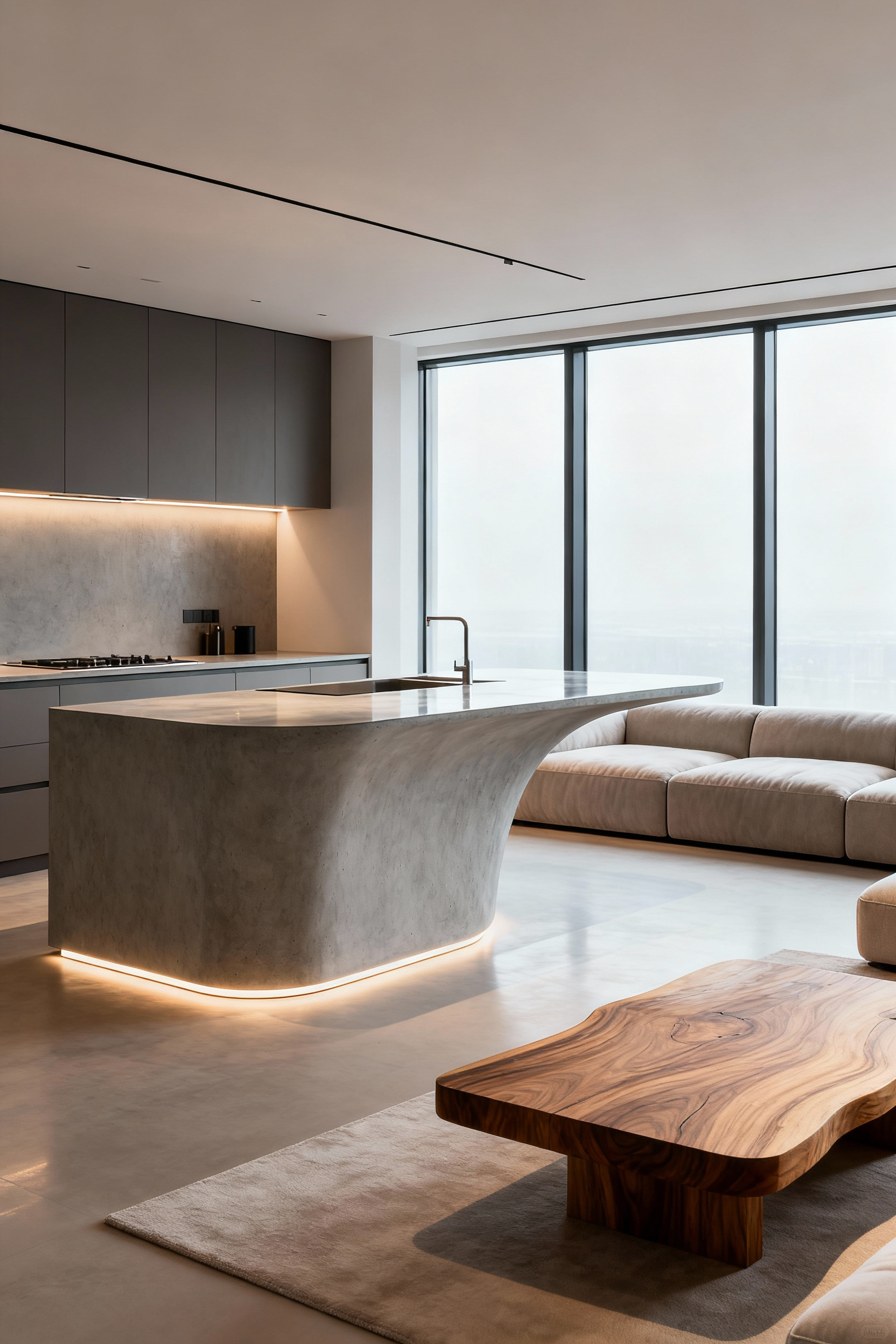
One of the best ways to manage this boundary is with a tiered design. A raised bar on the living room side creates a natural spot for guests to lean and chat while subtly hiding any prep-station clutter from view. Another approach I love is extending the island into the living area with a lower, table-height surface made from a different material, like wood. This blurs the line between “kitchen furniture” and “living furniture,” inviting a more holistic interaction. The island becomes a bridge, not a barrier, connecting the zones and elevating the experience of the entire space.
Foundational Concepts: Crafting the Ergonomic and Spatial Nexus (Part 2)
Lighting is too often an afterthought, but in a well-designed kitchen, it’s a foundational tool. It dictates utility and shapes mood. This section is all about orchestrating light to transform an island from a static object into a responsive, living focal point that works for every occasion.
5. Mastering Dynamic Lighting Design for Task Precision and Evocative Ambiance
A modern island demands more than a few pendants hanging overhead. True mastery lies in creating a layered, dynamic system that adapts to everything from intense meal prep to a relaxed evening cocktail. This means choreographing three types of light: ambient (general room light), task (focused work light), and accent (for drama and style). It starts with a simple question: what do you actually do at your island?
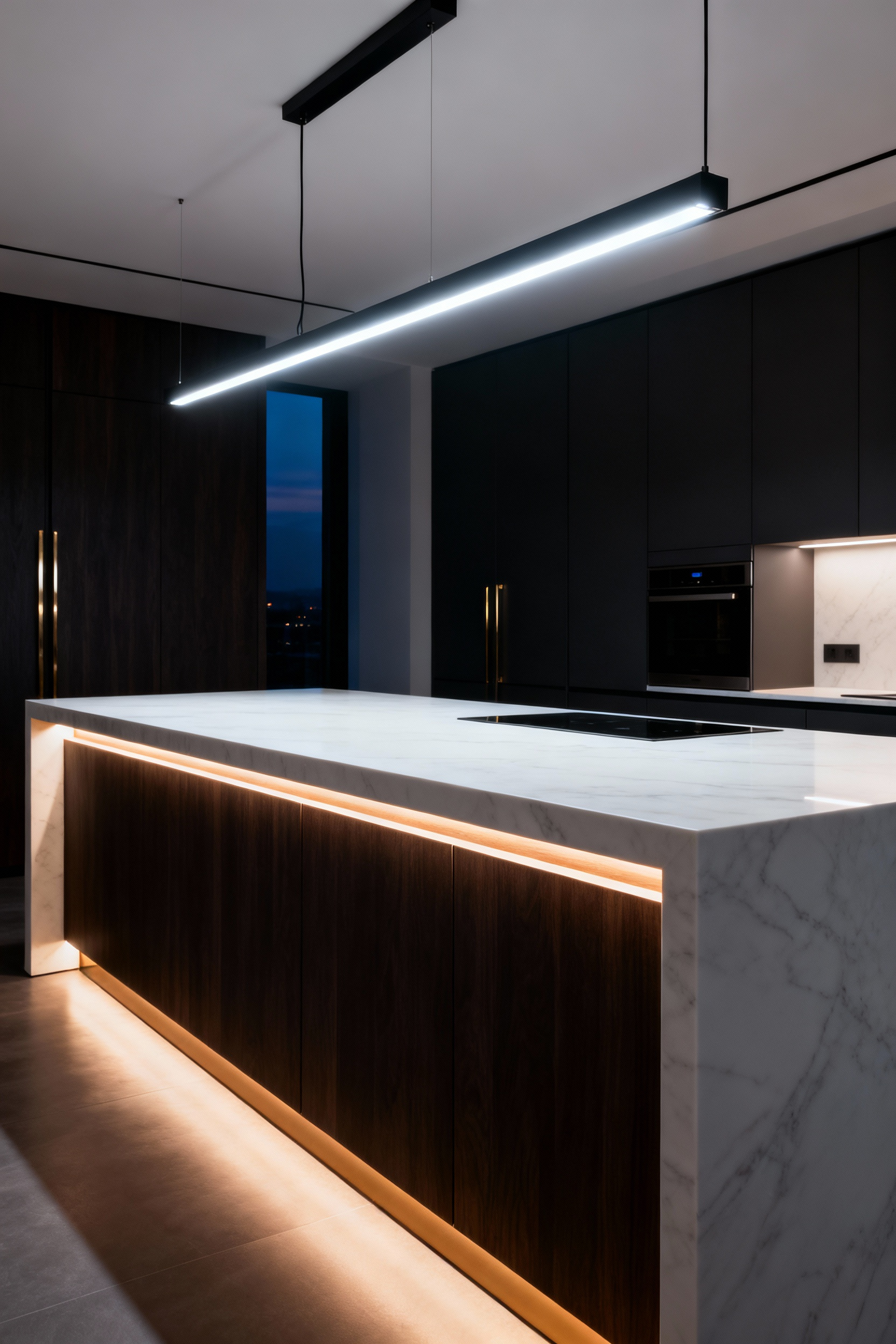
For prep work, you need bright, shadow-free light with a high Color Rendering Index (CRI) of 90+ to see the true colors of your ingredients. This is where recessed LEDs under shelves or focused downlights become essential. Then, you need the ability to transform that bright workspace into a soft, inviting place to gather. This is where tunable white technology is a game-changer, allowing you to shift the light from a crisp, cool daylight (around 4000K) for cooking to a warm, intimate glow (around 2700K) for entertaining. Finally, accent lighting can turn the island into a sculpture. A hidden LED strip under the countertop lip can make a heavy stone top feel like it’s floating. It’s about curating a sensory experience, using light to harmonize practicality with a profound sense of place.
Advanced Applications: Engineered Aesthetics and Multifunctional Innovation (Part 1)
Now we move beyond the basics into the realm of true innovation. This is where cutting-edge technology and smart architectural thinking meet, creating islands that are deeply integrated, incredibly adaptable, and visually stunning. This is how an island becomes the undisputed high-tech, high-style heart of the home.
6. Concealing Integrated Smart Appliances for a Streamlined and Uninterrupted Visual Plane
The goal of a sophisticated modern kitchen is a kind of serene minimalism, but that’s hard to achieve when you’re surrounded by a dozen gadgets and power outlets. I believe true elegance often lies in what you don’t see. The trick is to make advanced technology disappear until the moment you need it.
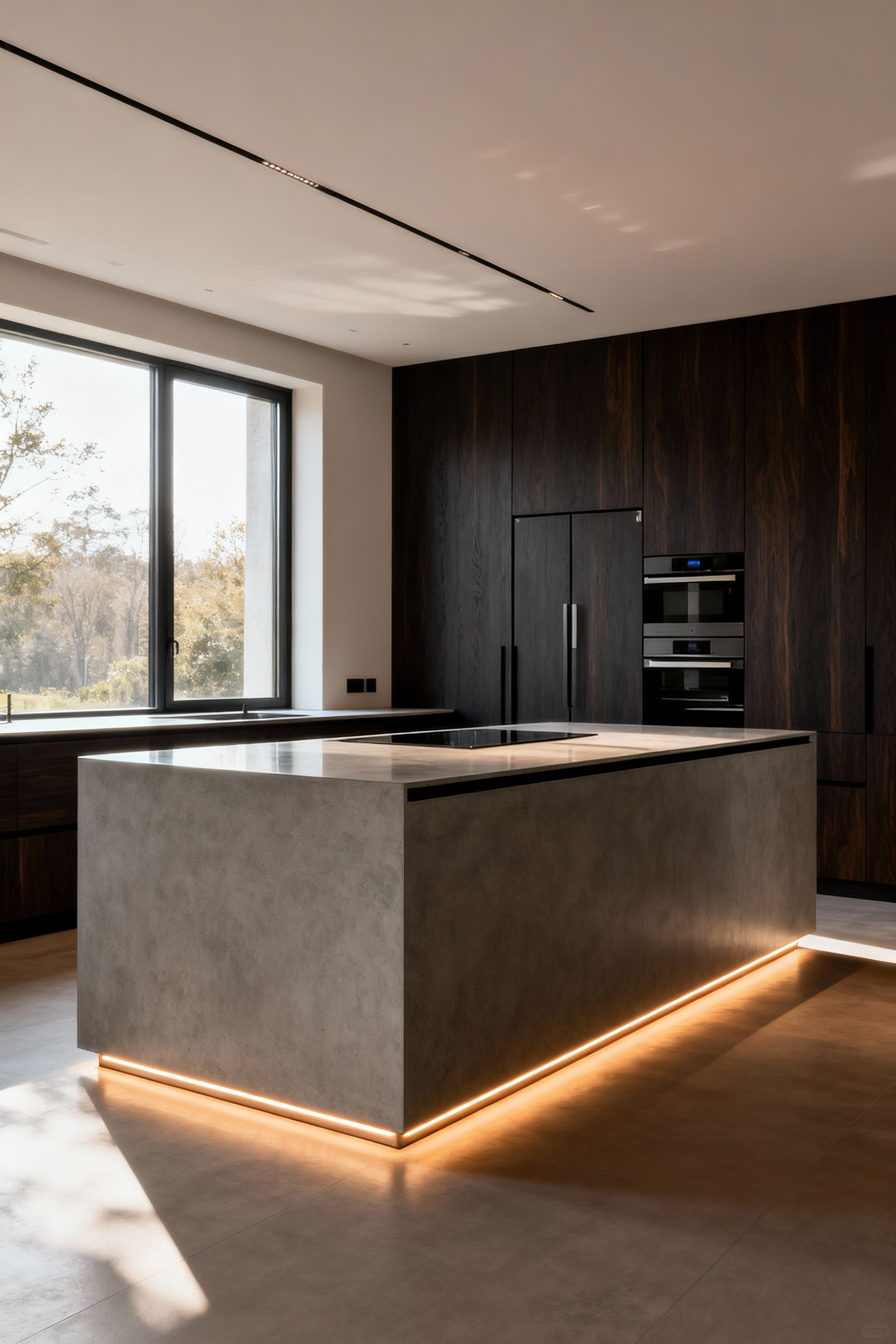
Instead of ugly outlets dotting the side of your beautiful island, think about motorized pop-up modules that rise from the countertop with a touch. An induction cooktop can sit perfectly flush, its controls invisible until activated, leaving you with an unbroken surface. Downdraft ventilation systems can retract completely, eliminating the need for a bulky overhead hood. It’s about preserving that clean, monolithic look. Years of professional experience taught me that achieving this level of concealment demands incredible precision in fabrication. Seams have to be perfect, and if you’re using a natural material like wood or stone, the grain or veining must continue flawlessly across panels to maintain the illusion. It’s a design philosophy where technology serves the aesthetic, not the other way around.
7. Dynamic Surface Expansion: Mechanized Retractability and Seamless Transition Systems
Why should an island be a fixed, static object? In today’s homes, flexibility is the ultimate luxury. Advanced islands can now transform their footprint and function on demand, thanks to mechanized systems that are as robust as they are elegant. This allows you to reconfigure your space instantly, moving from a compact prep area to a large dining surface.
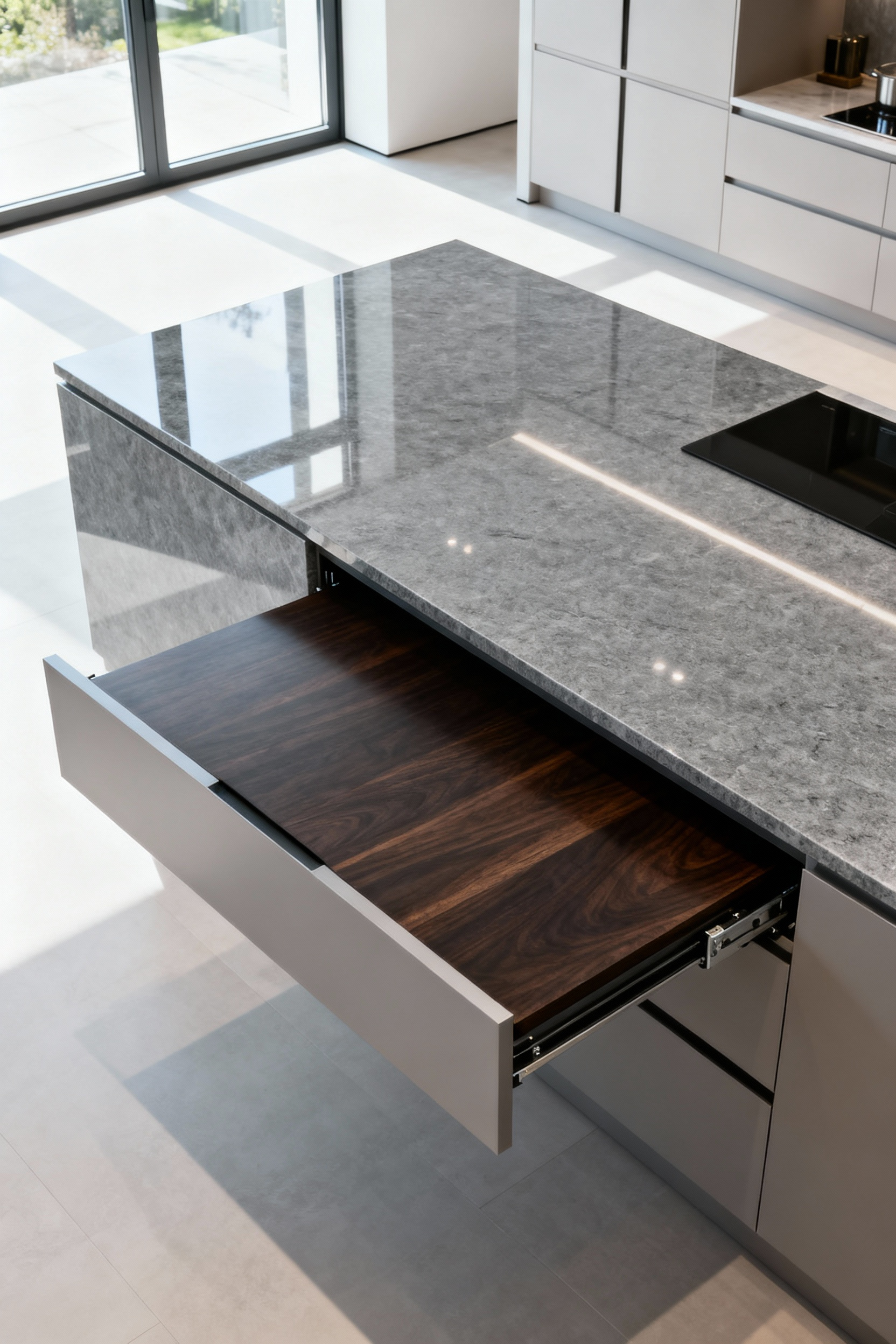
I’ve designed islands where a beautiful wood or stone surface glides out smoothly on precision-engineered runners, converting a four-person breakfast bar into a formal dining table for eight. The real art is making these transitions seamless. The retractable surface has to feel like an organic part of the whole, with minimal gaps and completely hidden mechanisms. Material continuity is key—the moving parts must match the fixed parts perfectly. This lets an island adapt to the rhythms of modern life, offering incredible utility without sacrificing an ounce of visual sophistication.
8. Sculptural Projections: Utilizing Cantilevering and Floating Forms for Visual Drama
When you approach an island as a piece of sculpture, it becomes the undisputed focal point of the home. One of the most powerful ways to achieve this is with cantilevers—bold, gravity-defying extensions that seem to float in space. It’s a look that’s both dramatic and surprisingly functional.
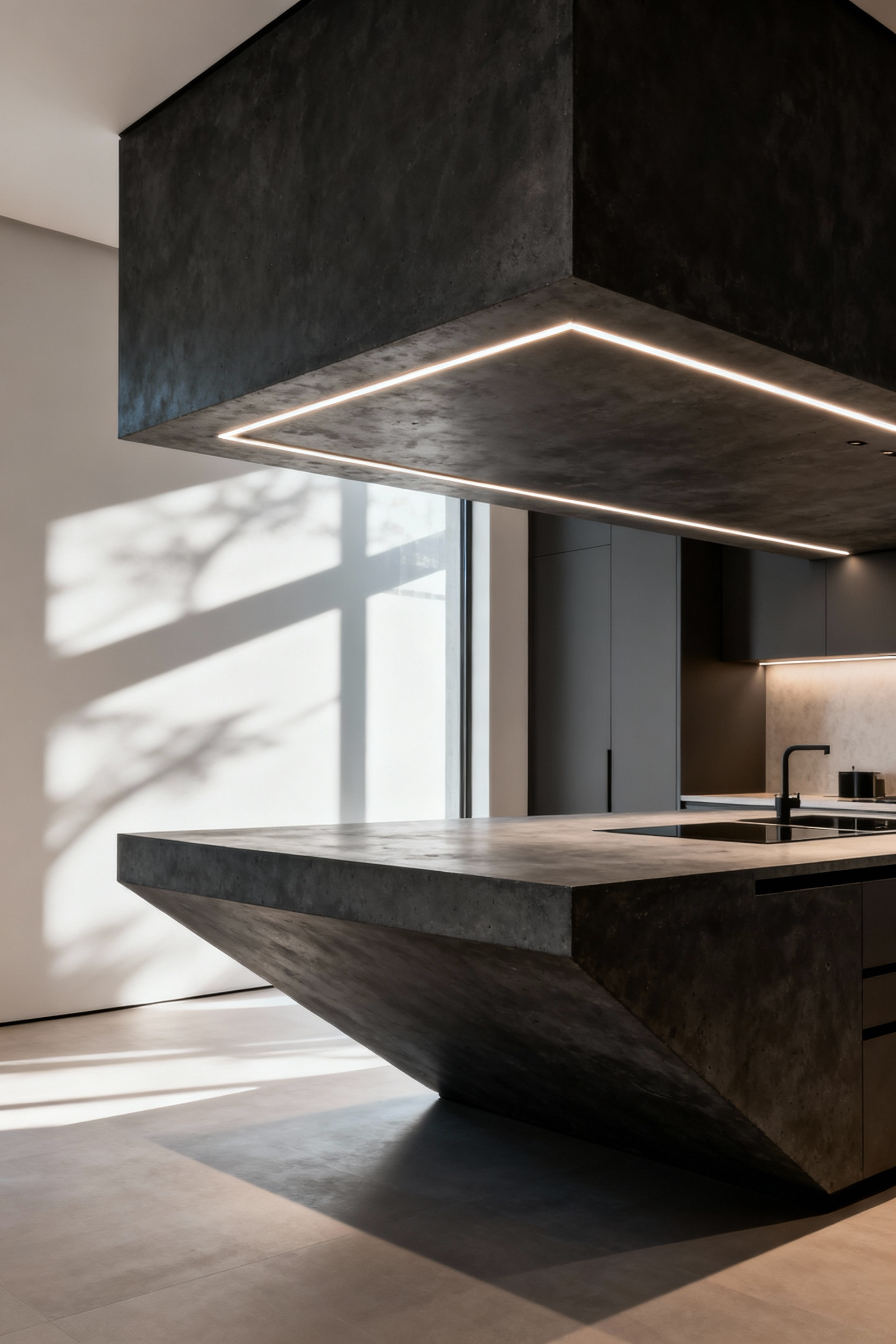
A cantilevered breakfast bar is a classic example. Instead of clunky support legs, a thick slab of stone or wood extends out from the island’s main structure, seemingly unsupported. This magic is possible thanks to a heavy-duty steel frame hidden within the island’s core, meticulously engineered to handle the load without any flexing. This not only creates incredible visual drama but also maximizes legroom for seating. You can also create a “floating” effect for the entire island by deeply recessing the base and adding under-cabinet lighting. The whole mass appears to hover just above the floor. This turns a utilitarian object into a genuine art installation.
9. Harmonizing Acoustical Properties within Open-Concept Kitchen-Living Schematics
In open-concept homes, the biggest complaint I hear is about noise. The clatter of pots and the whir of appliances from the kitchen can easily ruin a quiet evening in the living room. The modern kitchen island, sitting right at that intersection, can either be part of the problem or a key part of the solution.
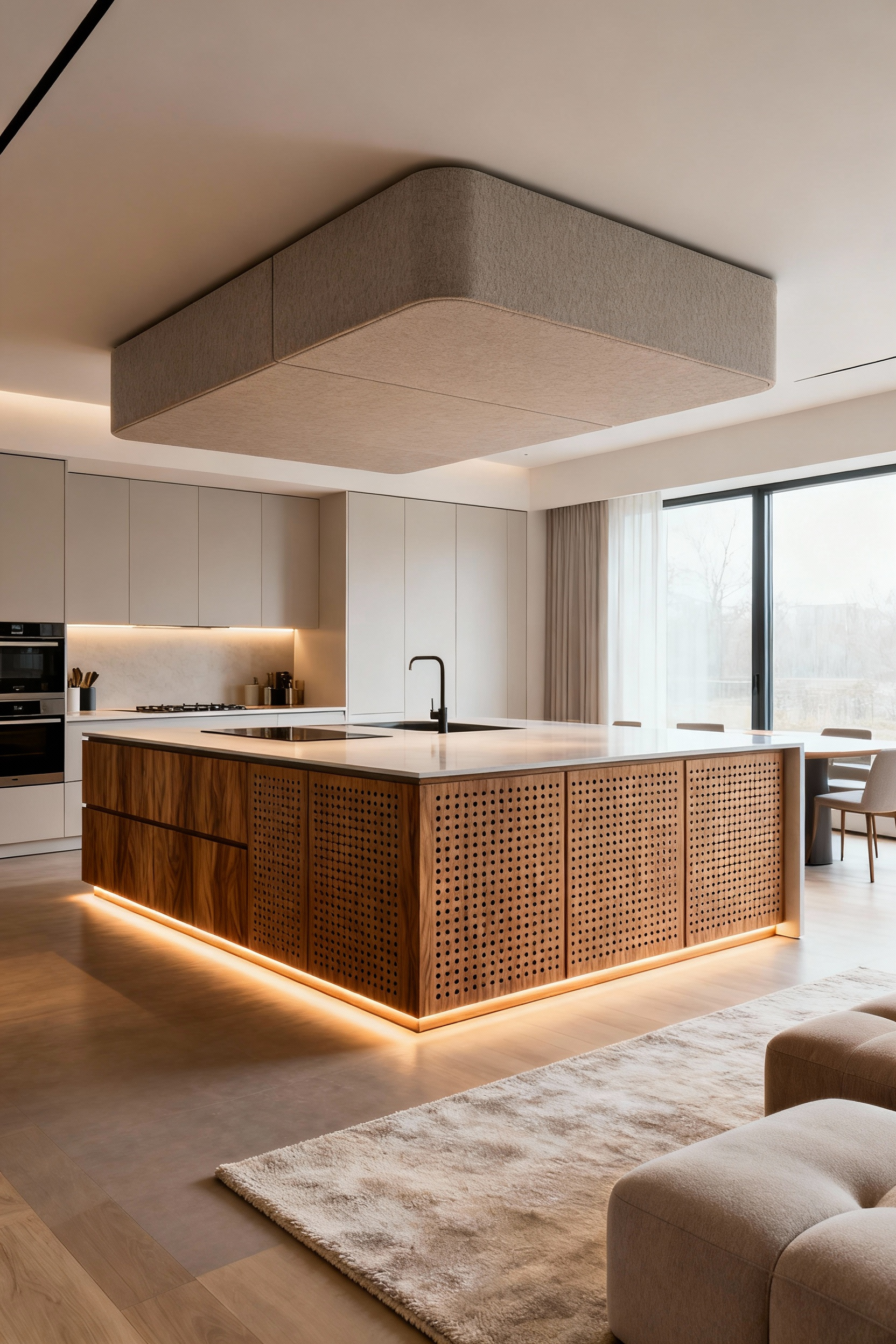
This is about smart material choices and design. Instead of purely hard, reflective surfaces, we can incorporate sound-absorbing elements. Think about slatted wood paneling on the island’s facade or even acoustically engineered textiles on the seating side. These materials subtly diffuse and dampen sound. Housing the noisiest appliances—like the dishwasher—inside the island with extra insulation also makes a huge difference. By thinking about acoustics from the start, we can design an island that acts as an acoustic buffer, ensuring your open-plan home feels connected and serene, not chaotic and loud.
Advanced Applications: Engineered Aesthetics and Multifunctional Innovation (Part 2)
Here, we explore the finer points of craftsmanship that distinguish a truly exceptional island. It’s about moving past standard solutions to embrace custom work that reflects meticulous design and a deep respect for skill. This is what gives an island its soul.
10. Employing Custom Joinery for Bespoke Storage Solutions and Exemplary Craftsmanship
Off-the-shelf cabinets have their place, but a truly distinguished modern kitchen island deserves custom joinery. This isn’t just about building boxes; it’s a philosophy of absolute precision, where every detail is calibrated to your exact needs and the specific character of your home. It’s a commitment to a seamless, integrated piece of furniture.
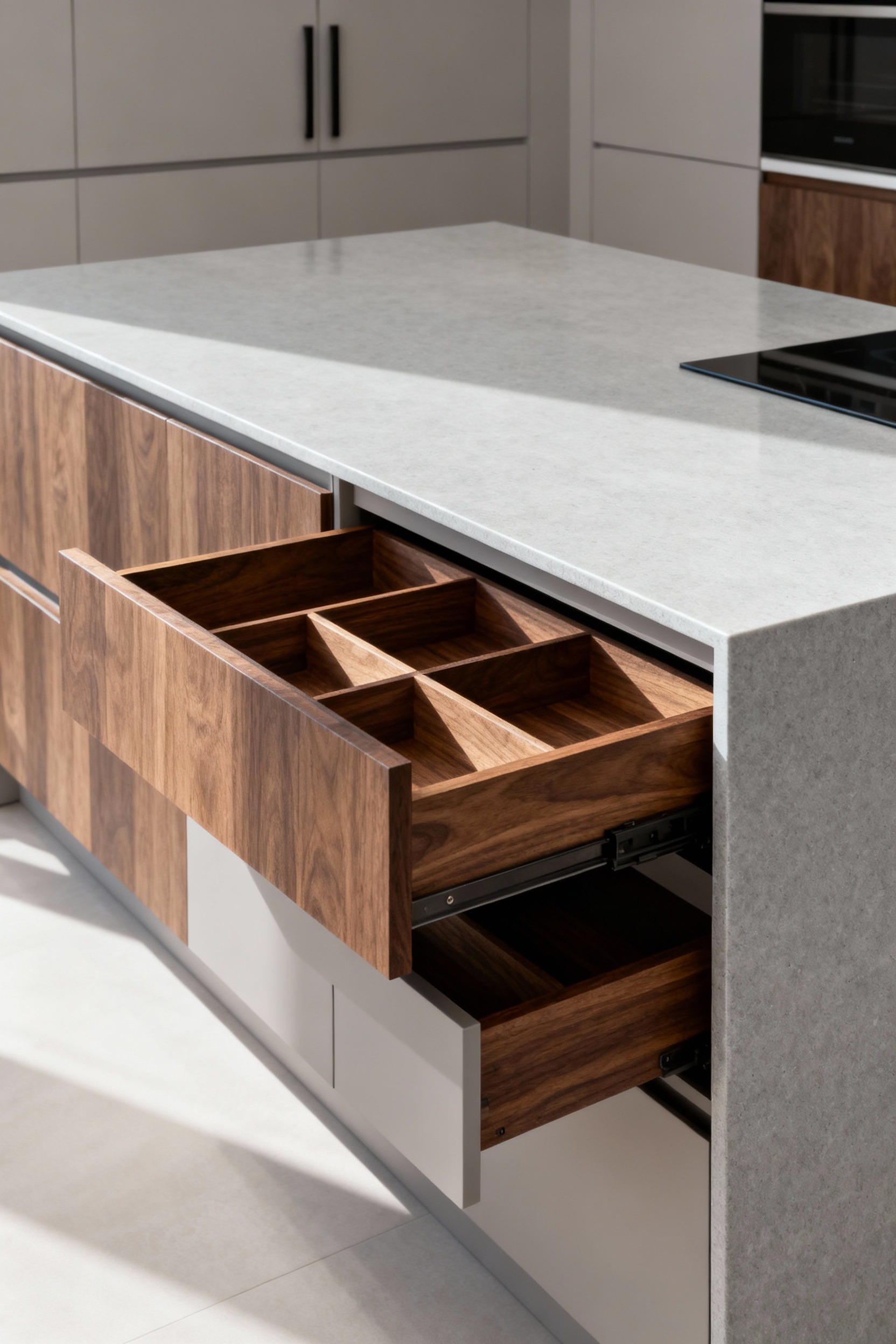
The beauty of custom joinery is in its bespoke storage. We can design internal drawer dividers perfectly fitted to your cutlery, knife blocks that disappear into the countertop, or spice racks engineered to retract silently. It’s about anticipating your every move and creating a place for everything. This is also how we flawlessly conceal technology—charging stations, waste bins, or wine fridges—behind perfectly aligned panels that maintain the island’s monolithic form. What really gets me is the level of craftsmanship you can achieve. Think dovetail joints, perfectly matched wood grain that flows across every drawer front, and the whisper-quiet operation of every moving part. It’s this meticulous attention to detail that ensures the island will not only last for generations but will feel exceptional every single day.
Philosophical Context: Purity of Form and the Enduring Legacy of Materials (Part 1)
A great island is more than the sum of its parts. It has a presence, a character. This section explores the deeper ideas that give an island its enduring appeal, from the honest expression of its materials to the deliberate cultivation of a sensory experience.
11. Cultivating Material Veracity: Embracing the Authentic Patina of Natural Surfaces
There’s a powerful honesty in natural materials that you just can’t replicate. Instead of chasing a sterile, factory-perfect look, this philosophy is about celebrating the way real materials—stone, wood, metal—age and evolve over time. It’s about embracing the authentic patina that tells the story of a life lived around the island.
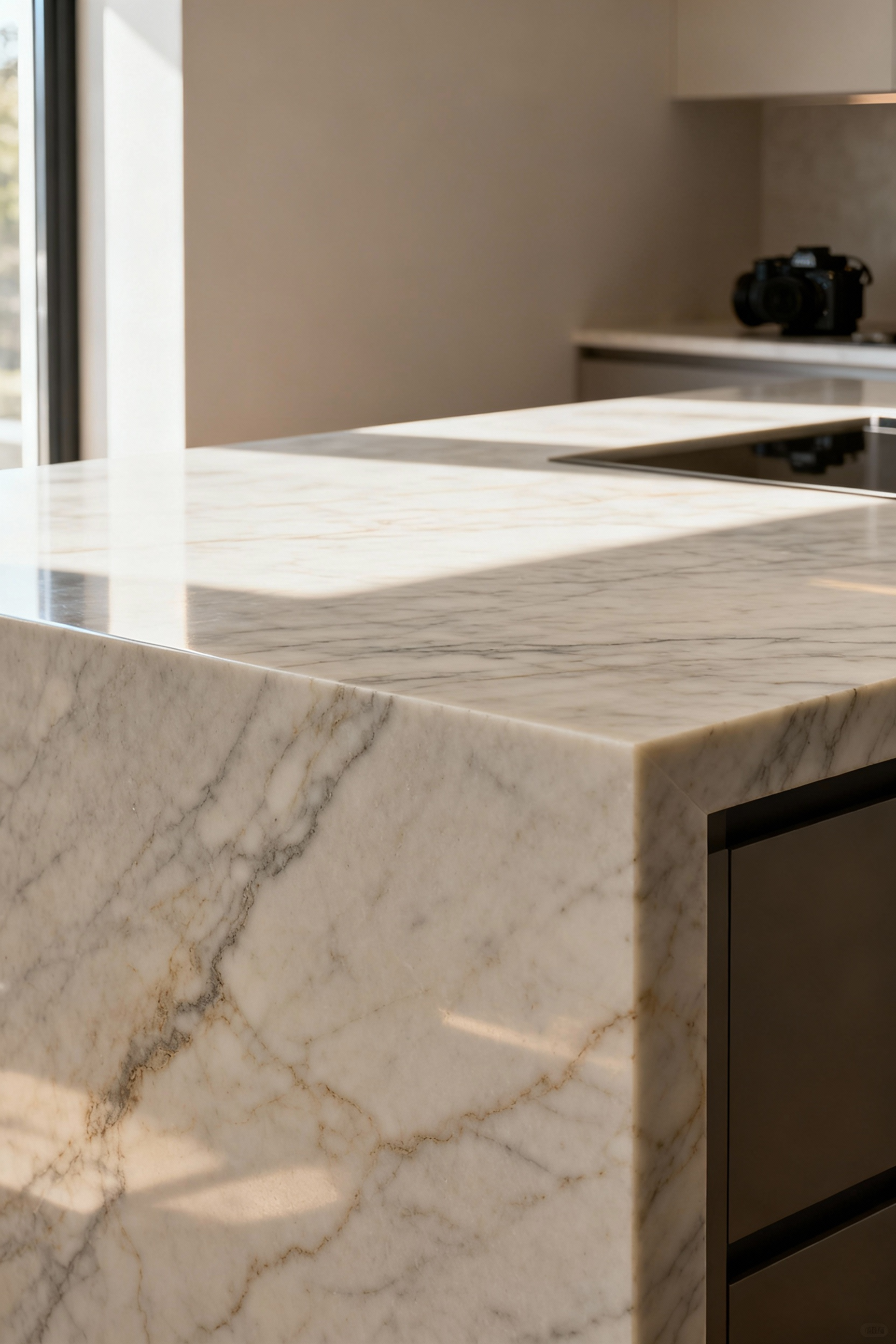
Think about a countertop of honed marble. Rather than fighting every little etch mark from a slice of lemon, we can choose to see them as part of the material’s story. These aren’t flaws; they are chronicles of shared meals and happy memories. The same goes for unlacquered brass hardware that darkens over time or a solid wood breakfast bar that develops a rich luster from years of use. This isn’t about being precious; it’s about choosing materials with soul. In my work, connecting a home to its history is key, and an island that ages gracefully becomes an artifact—a future antique resonant with the spirit of craftsmanship and enduring natural elegance.
12. The Deliberate Omission: Sculpting Negative Space for Visual Serenity and Focus
Sometimes, the most powerful element in a design is what isn’t there. Negative space—the carefully composed absence of stuff—is a tool for creating visual serenity. By deliberately omitting unnecessary elements, we allow the island’s form and materials to speak for themselves, creating a sense of calm and focus.
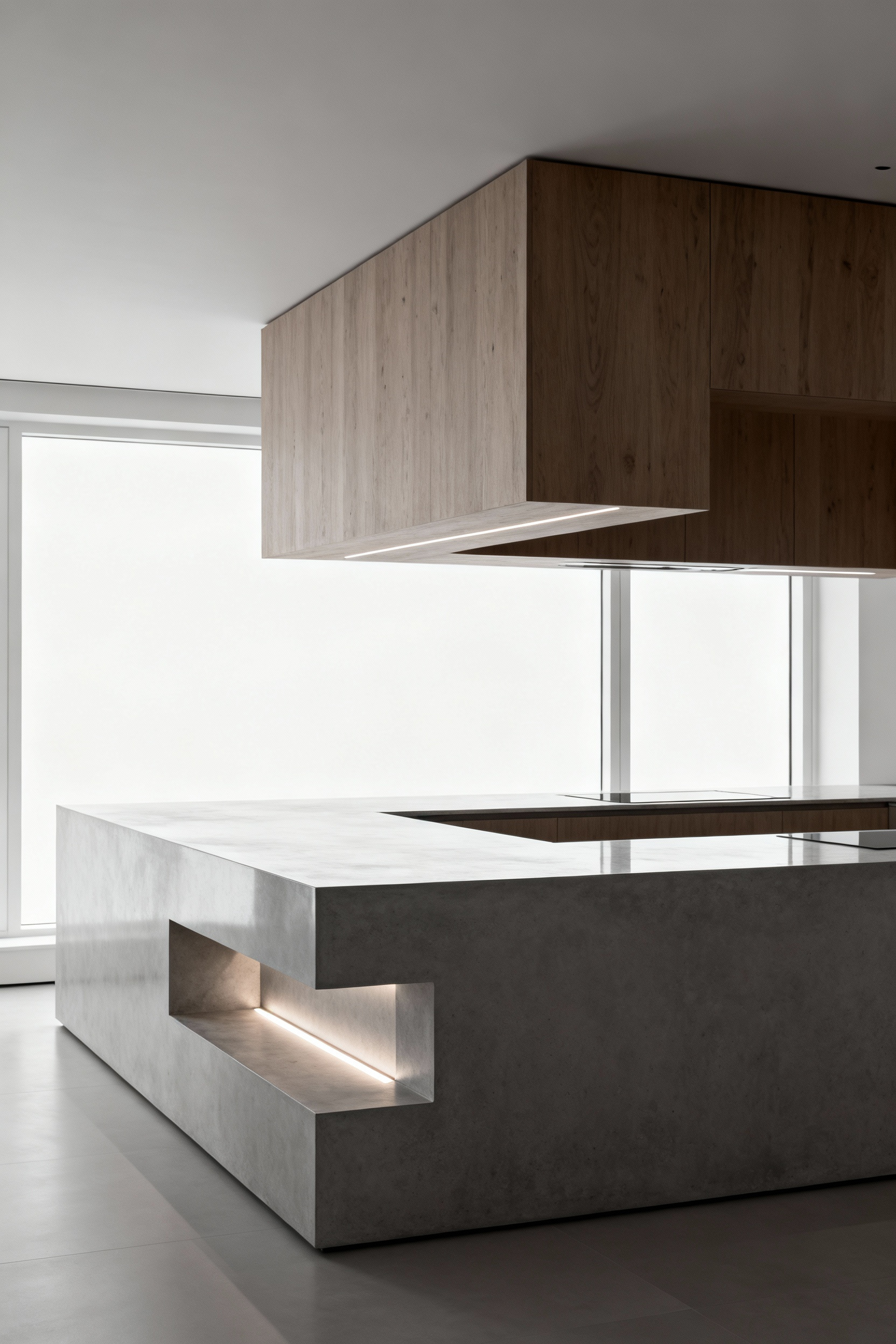
On an island, this might mean designing a cantilevered top that creates a large, open space beneath it, making the whole structure feel lighter and more elegant. It means choosing handleless, push-to-open cabinetry to maintain clean, unbroken lines. This isn’t about stark emptiness; it’s about distillation. By stripping away visual clutter, each remaining component gains importance. You could design a single open niche in the island’s mass to perfectly frame a few treasured cookbooks. It’s an approach that elevates the island from a utilitarian box to a statement of sophisticated quietude.
13. Infusing Biophilic Elements: Bridging Indoor Habitation with Restorative Natural Forms
Biophilia is our innate human need to connect with nature. Bringing natural, living elements into the heart of the kitchen transforms an island from a purely functional object into a grounding, life-affirming hub. This goes way beyond just putting a plant on the counter.
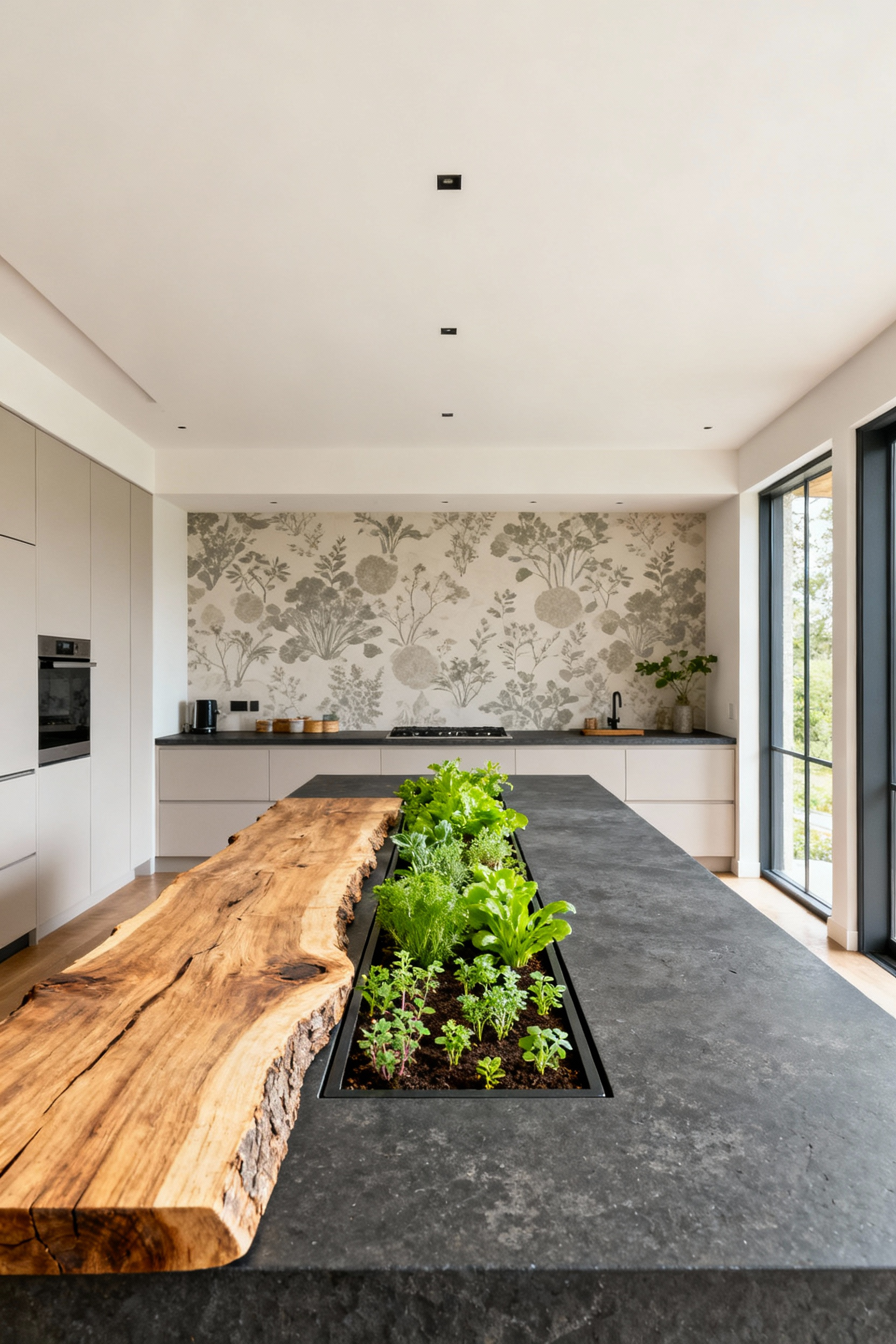
Imagine a small section of the island designed as an integrated, self-watering herb garden, offering fresh ingredients and a constant connection to something living. You can also evoke nature through materials—the swirling patterns in a slab of quartzite, the rhythmic grain of wood, or the textural feel of raw concrete. I learned this when I worked on a project where we designed a thin, recessed channel into the stone countertop for a tiny, recirculating water feature. It was nearly invisible, but the subtle sound of flowing water completely changed the feeling of the room. It’s about creating a multisensory experience that reduces stress and enhances well-being.
14. Curating Sensory Modalities: Integrated Control of Temperature, Sound, and Olfactory Experience
The most sophisticated designs engage all the senses. A truly exceptional modern kitchen island can be engineered to actively shape the temperature, sound, and even smell of the space around it, creating an environment of profound comfort. This is the next level of luxury.
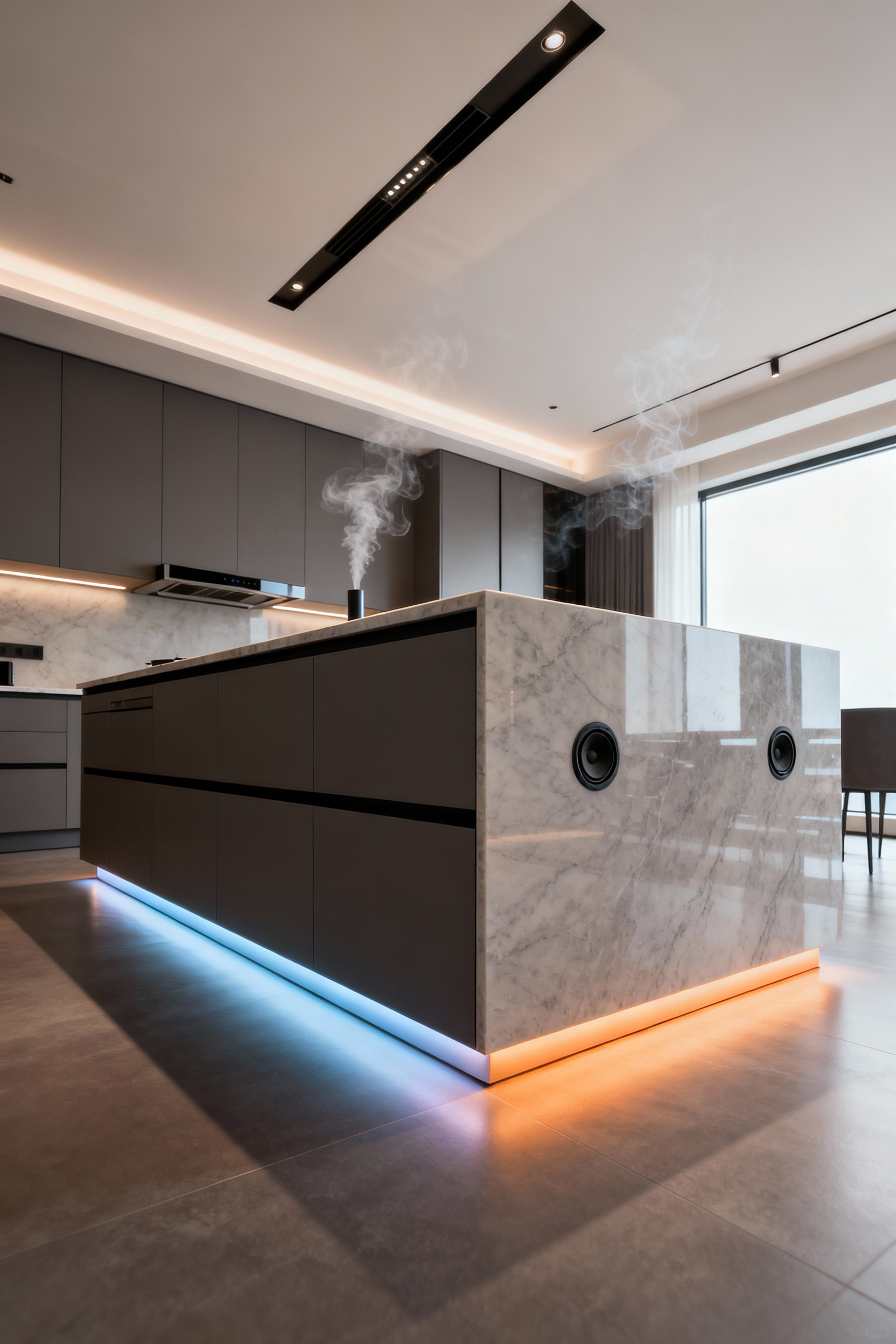
Think about temperature. Beyond a simple warming drawer, you can have zones in the countertop itself that can be heated to keep serving dishes warm or cooled for prepping pastry. In terms of sound, using sound-dampening materials inside the island and choosing ultra-quiet appliances creates an oasis of calm. And for the olfactory experience, a high-performance downdraft vent is key to managing cooking aromas, while a discreetly integrated diffuser or a place for fresh herbs can introduce pleasant scents. By orchestrating these sensory layers, the island becomes a truly immersive environment, finely tuned to provide unparalleled comfort.
Philosophical Context: Purity of Form and the Enduring Legacy of Materials (Part 2)
This final philosophical exploration looks at minimalism not as a style, but as a discipline. It’s a rigorous process of refining an object down to its essential form, achieving an elegance that is both timeless and deeply functional.
15. Applying Principled Minimalism: Distilling Functionality to its Essential and Elegant Form
Minimalism isn’t about having less; it’s about making sure that every single thing you have is perfect. It’s a design philosophy that strips away every non-essential element to reveal the pure, elegant form of an object’s function. Applied to a modern kitchen island, this means relentlessly questioning every detail. Is this curve necessary? Does this hardware add anything but visual clutter?
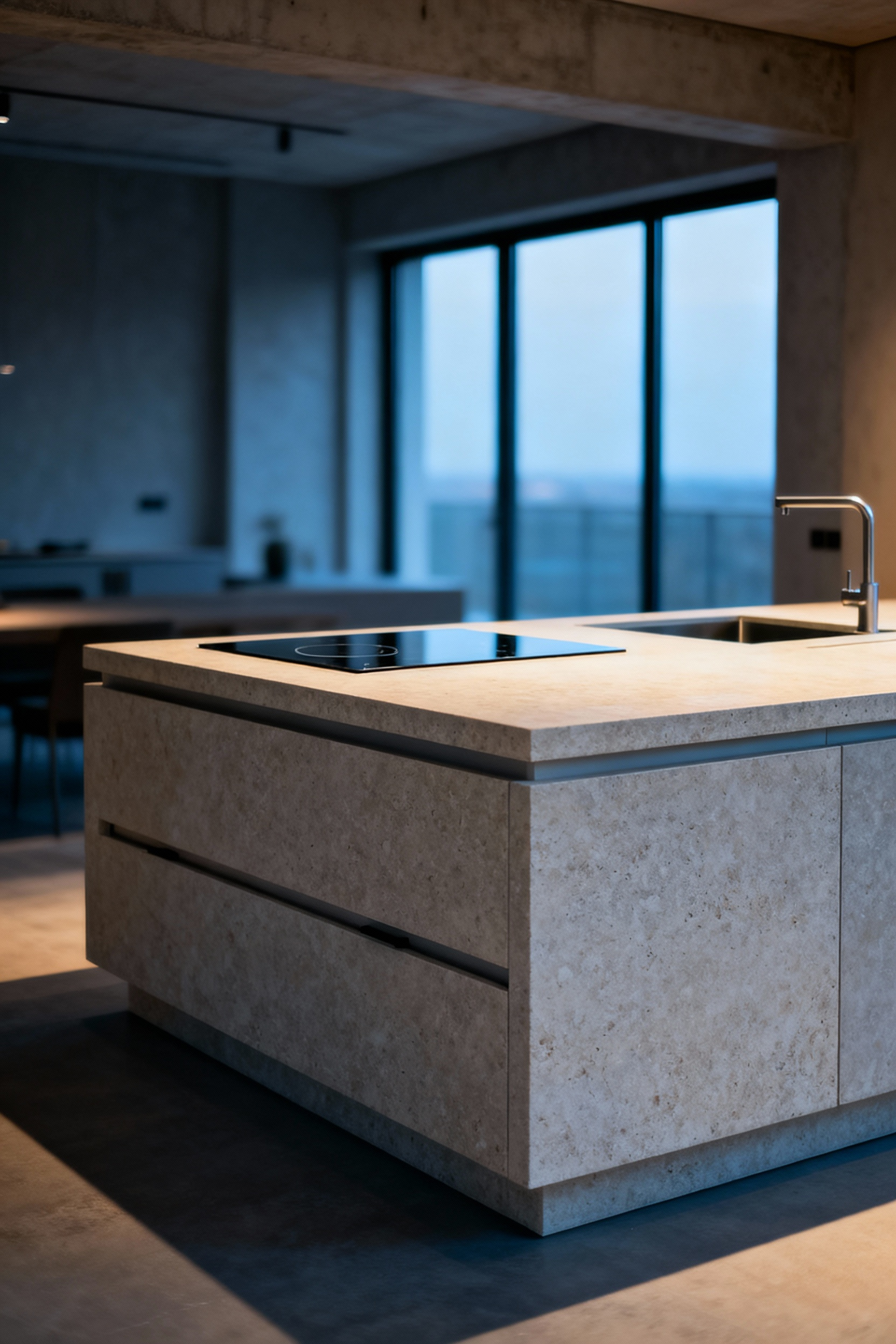
A truly minimalist island communicates strength and sophistication through its clean lines and unadorned materials—like a waterfall edge in a single, unbroken slab of stone. It’s not about avoiding details, but about perfecting the necessary ones. Every drawer, every recess, every transition is meticulously considered to serve its purpose with maximum efficiency and quiet grace. From my work in period-appropriate renovation, I’ve learned that timelessness comes from this kind of integrity. A design that is pure, honest, and perfectly executed will never go out of style.
Realizing Vision: Precision Implementation and Future-Centric Design (Part 1)
A brilliant idea is only as good as its execution. This section covers the practical, brass-tacks challenges of bringing a visionary island to life—from coordinating master craftspeople to ensuring the design is built to last for generations to come.
16. Navigating Bespoke Fabrication: Orchestrating Cross-Disciplinary Artisanal Collaboration
An exceptional modern kitchen island is rarely a product you can buy off a showroom floor. It requires a bespoke approach, which means orchestrating a team of highly skilled artisans: cabinet makers, stonemasons, metal fabricators, electricians, and smart home specialists. My role is often like a conductor, making sure everyone’s contribution is perfectly harmonized.
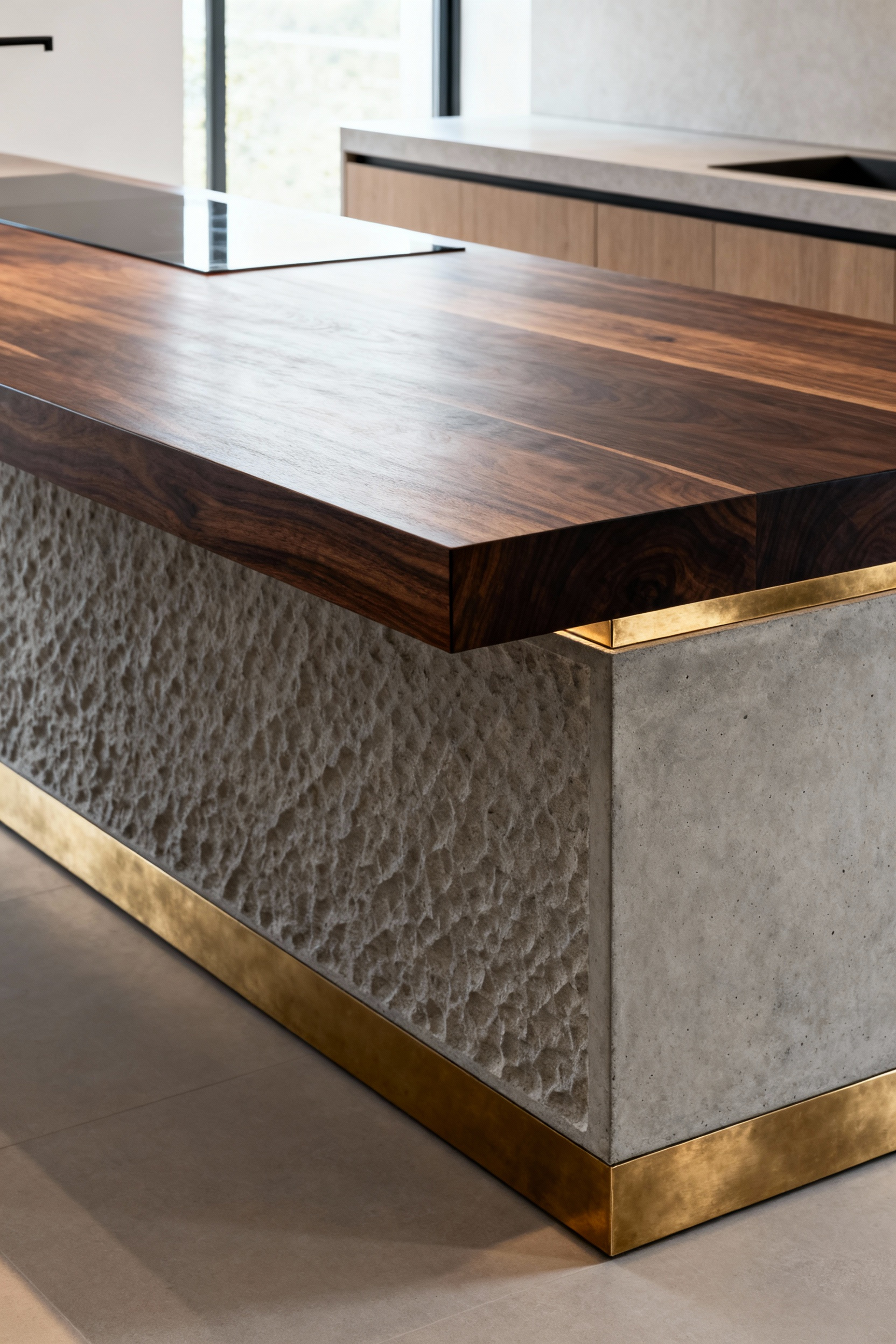
The key is to have everyone at the table from the beginning. We use detailed digital models to ensure the metalworker’s steel frame will perfectly support the stonemason’s marble slab, and that the electrician’s wiring conduits are exactly where they need to be before any material is cut. This proactive, collaborative process avoids costly mistakes and ensures every component fits together flawlessly. This meticulous choreography of skills is what elevates a great concept into a stunning, functional masterpiece.
17. Mitigating Technological Obsolescence Through Adaptive and Future-Proof Infrastructure
Building technology into a permanent fixture like an island is risky—today’s cutting-edge gadget is tomorrow’s obsolete relic. True future-proofing isn’t about having the latest tech; it’s about creating a flexible infrastructure that can adapt to whatever comes next.
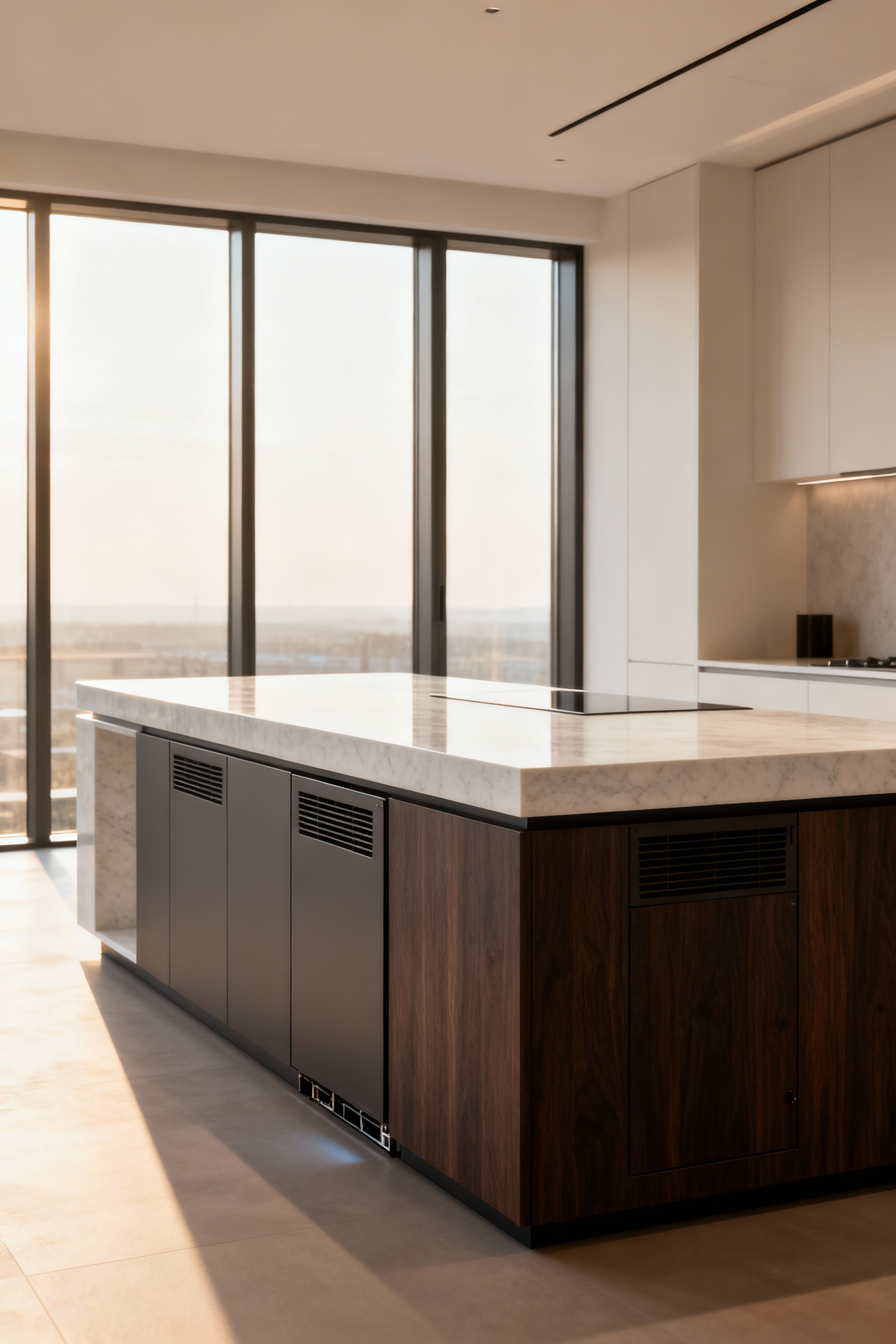
Instead of hardwiring a specific type of USB port, for example, we’ll run an accessible conduit to a modular power track. This way, in five years, you can easily swap out the components for the new standard. For integrated screens or smart appliances, we design compartments with standardized connections and plenty of ventilation, making future upgrades simple. The core principle is “layered permanence”: the permanent parts (structure, countertops) are designed to accommodate the easily-changed parts (electronics). This turns the island into an evolving hub, always ready for the future.
18. Safeguarding Material Integrity with Advanced Surface Treatments and Protective Finishes
Beautiful materials need to be protected. The surfaces of a modern kitchen island face a daily onslaught of heat, spills, acids, and abrasions. Choosing the right advanced surface treatments is absolutely critical to preserving their integrity and beauty for the long haul.
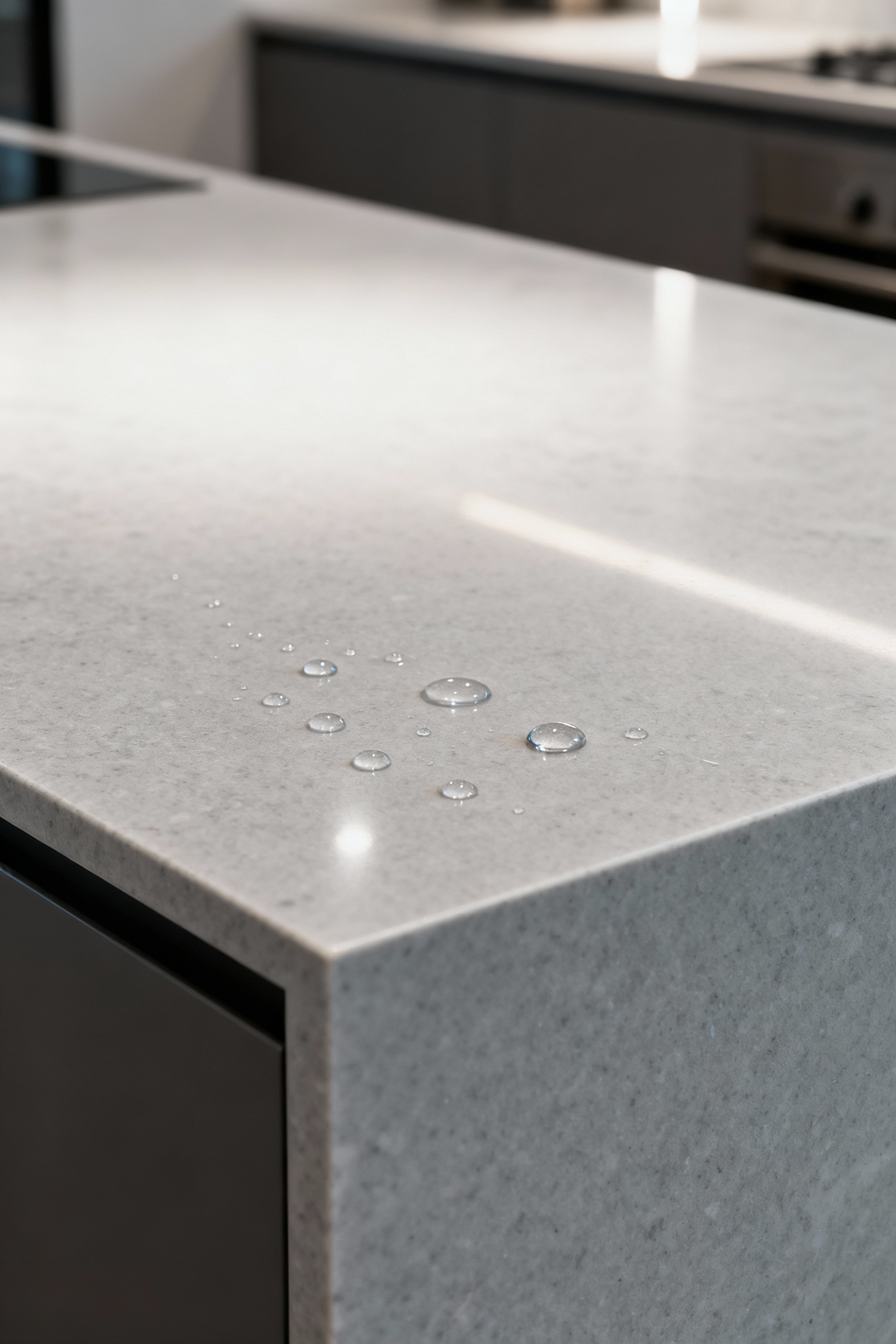
Every material needs a specific strategy. Porous stones like marble need a high-quality penetrating sealer to prevent stains. Wood needs a durable finish to protect it from moisture and scratches. Even concrete needs a specific topical sealer to prevent etching. There are now incredible new technologies, like ceramic coatings that provide a microscopically hard barrier against scratches, and hydrophobic treatments that make liquids bead up and roll right off. I always provide my clients with a clear maintenance plan, because safeguarding these beautiful materials ensures the island remains elegant for decades.
19. Legacy Integration: Subtly Echoing Historic Architectural Vocabularies within Modern Contexts
A truly masterful modern kitchen island doesn’t exist in a vacuum. It feels right in its space because it engages in a quiet dialogue with the home’s existing architecture. This isn’t about copying historical details, but about subtly echoing foundational design principles. It’s about creating a sense of deep continuity.
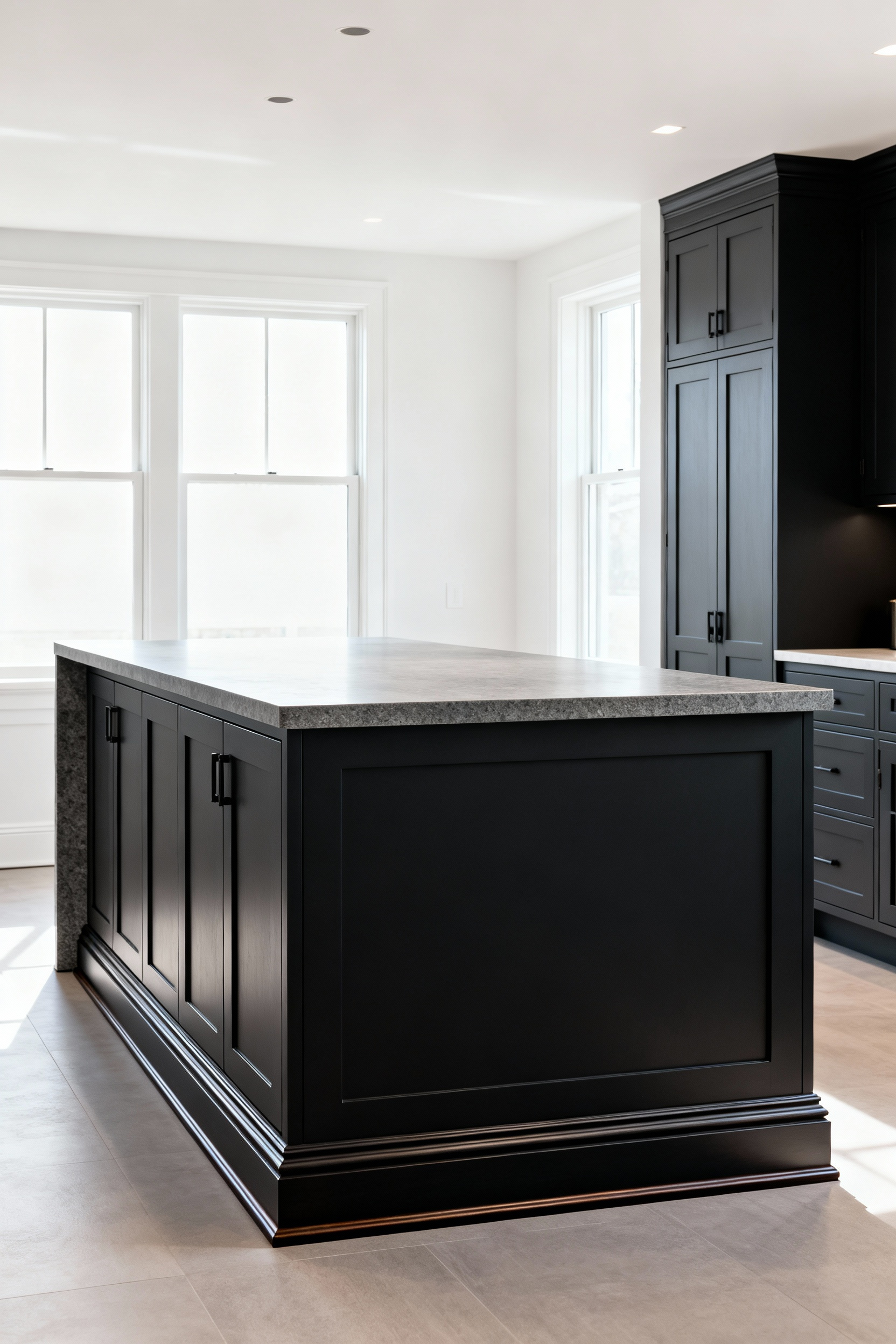
In a Victorian home, for example, an island’s leg profiles might subtly hint at the turned legs of period furniture, but be rendered in a clean, modern way. The proportion of the island’s mass might be inspired by classical principles of symmetry and balance. You could use a local stone that’s been part of the region’s architecture for centuries, but give it a contemporary honed finish. This subtle interweaving of past and present gives the island a gravitas and an aesthetic longevity that transcends trends. It becomes not just a functional hub, but a significant architectural element in the story of the home.
Realizing Vision: Precision Implementation and Future-Centric Design (Part 2)
The true test of design isn’t just how it looks on day one, but how it performs and endures over a lifetime. This is about making choices that guarantee resilience, serviceability, and sustained value, ensuring the island remains a relevant and beautiful centerpiece for decades.
20. Implementing Lifecycle Design: From Commissioning to Sustained Excellence and Value
Lifecycle design means thinking about an island’s entire existence—from sourcing materials to its eventual repair or adaptation decades from now. It starts with choosing robust materials that age with grace rather than degrading, and building with superior joinery and hardware that can withstand years of heavy use. This lays the foundation for an island that serves as a steadfast family heirloom, not a disposable trend.
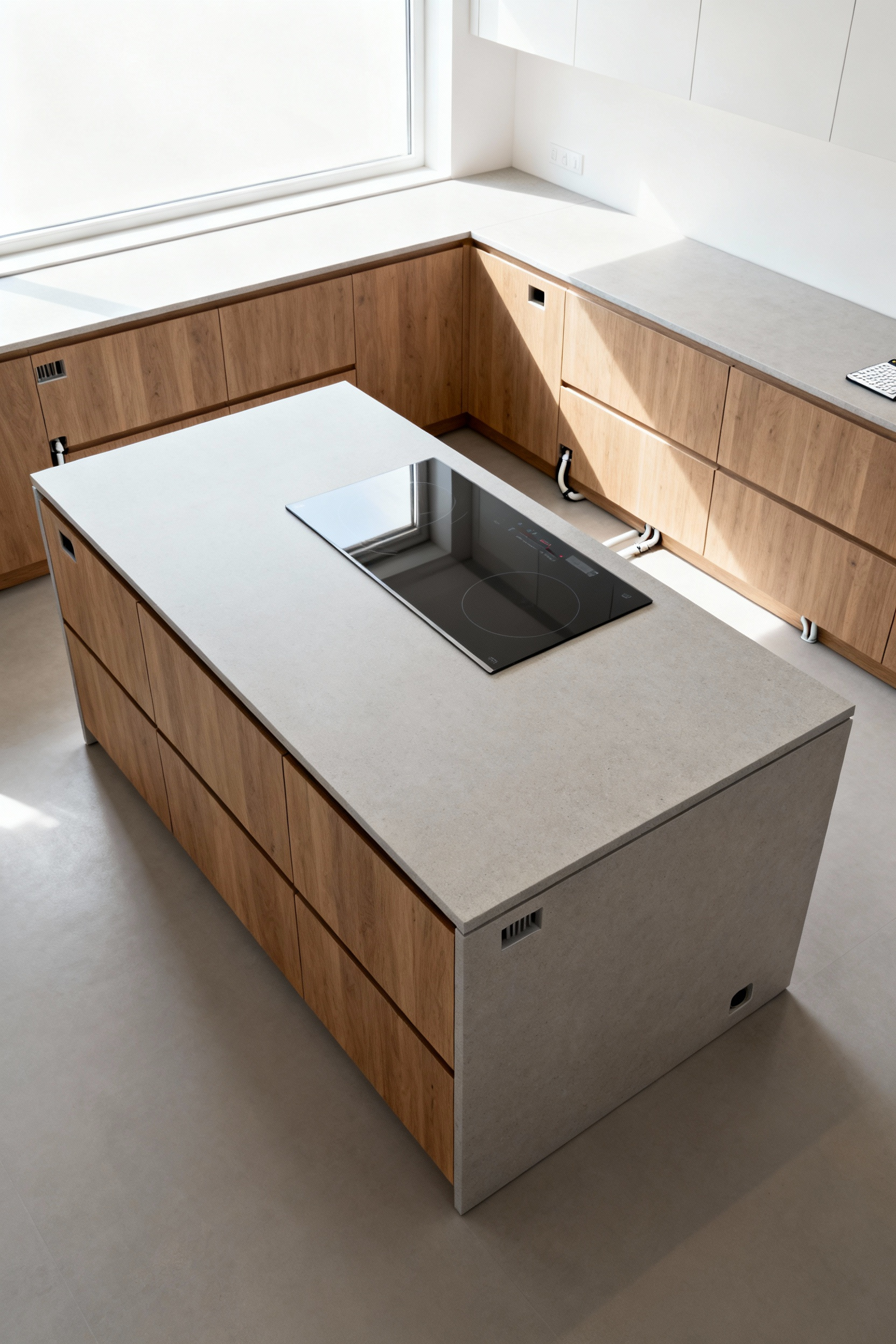
The more advanced application of this philosophy is designing for serviceability. Can a plumber easily access the pipes for the prep sink without tearing out the cabinetry? Can an appliance be swapped out for a newer model in ten years without a major demolition? By making components accessible and replaceable, we build in longevity and avoid wasteful overhauls. This is a profound commitment to sustainability and a rejection of disposable culture. A well-designed modern kitchen island is a legacy piece, a testament to quality that proves its worth through decades of unwavering performance.
Conclusion
As we’ve seen, designing a modern kitchen island is about so much more than choosing a countertop and some cabinets. When approached with thoughtfulness and a respect for craftsmanship, what was once a simple utility becomes the true heart of the home—a place where cooking, conversation, and daily life converge. It embodies our desire for beauty, efficiency, and connection.
The synthesis of these principles—from the ergonomics of workflow to the honest expression of materials—is where the real artistry lies. The goal is to create something that is not just seen but deeply felt, an island that is both a high-performance tool and a beautiful piece of furniture. You now have a blueprint for approaching this centerpiece with clarity and confidence. Use it to create something that isn’t just an installation, but an architectural statement that will enrich your home and your life for generations to come.
